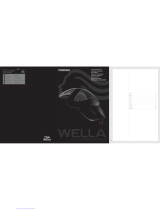
38630, Ausgabe/Edition 2012-05, Version 8
3
1 Hinweise zum sicheren Gebrauch ...................... 4
1.1 Bildzeichenerklärung......................................... 6
1.1.1 Zeichen in der Gebrauchsanweisung .......... 6
1.1.2 Bildzeichen am Gerät und/oder auf der .........
Verpackung.................................................. 6
1.1.3 Angaben auf dem Typenschild (Abb.1) ............. 8
1.2 Allgemeine Sicherheitshinweise ....................... 9
1.2.1 Normen und Richtlinien ............................... 9
1.2.2 Zweckbestimmung....................................... 9
1.2.3 Bestimmungswidriger Gebrauch.................. 9
1.2.4 Kontraindikation ........................................... 9
1.2.5 Umgebungsbedingungen für Betrieb und ......
Lagerung ................................................... 10
1.2.6 Reinigung und Desinfektion....................... 10
2 Gebrauch der ACROBAT Swing Geräte ........... 11
2.1 Komponenten der Geräte (Abb. 2) ................. 11
2.2 Gebrauch (Abb. 2) .......................................... 11
2.3 Entsorgung ..................................................... 14
3 Reinigung und Desinfektion ............................. 15
3.1 Allgemeine Sicherheitshinweise ..................... 15
3.2 Reinigung........................................................ 15
3.3 Desinfektion .................................................... 15
4 Prüfungen und Wartung .................................... 16
4.1 Prüfungen ....................................................... 16
4.2 Wartung .......................................................... 16
5 Instandhaltung ................................................... 17
5.1 Federkraft nachstellen (Abb. 3) ...................... 17
5.2 Sicherungssegment fetten .............................. 19
6 Demontage und Montage im Servicefall .......... 20
6.1 Endgerät demontieren (Abb. 4) ...................... 20
6.2 Endgerät montieren (Abb. 5) ......................... 21
6.3 Austausch der Sicherungen (Abb. 6) .............. 23
7 Technische Daten............................................... 25
8 Inspektionsplan.................................................. 26
Inhaltsverzeichnis SeiteContent Page
1 Instructions for safe usage ................................. 4
1.1 Explanation of symbols ..................................... 6
1.1.1 Symbols in the operating instructions .......... 6
1.1.2 Marking on the equipment ........................... 6
1.1.3 Information on the rating plate (Fig.1)............... 8
1.2 General Safety indications ................................ 9
1.2.1 Standards and guidelines ............................ 9
1.2.2 Intended purpose......................................... 9
1.2.3 Incorrect use................................................ 9
1.2.4 Contraindications ......................................... 9
1.2.5 Ambient conditions for operation and
storage....................................................... 10
1.2.6 Cleaning and Disinfection .......................... 10
2 Using the ACROBAT Swing Equipment ........... 11
2.1 Components of the equipment (Fig. 2) ........... 11
2.2 Usage (Fig. 2) ................................................ 11
2.3 Disposal .......................................................... 14
3 Cleaning and Disinfection ................................. 15
3.1 General Safety indications .............................. 15
3.1 Cleaning.......................................................... 15
3.2 Disinfection ..................................................... 15
4 Tests and Maintenance ...................................... 16
4.1 Tests ............................................................... 16
4.2 Maintenance ................................................... 16
5 Maintenance ....................................................... 17
5.1 Adjusting the spring force (Fig. 3) ................... 17
5.2 Greasing the securing segment ...................... 19
6 Dismantling and mounting for service............. 20
6.1 Dismantling for end-device (Fig. 4) ................. 20
6.2 Mounting the end-device (Fig. 5) ................... 21
6.3 Change the fuses (Fig. 6) ............................... 23
7Technical Data .................................................... 25
8 Inspection Plan .................................................. 26





















